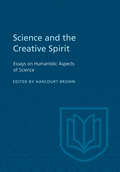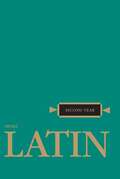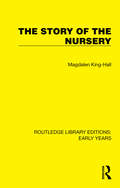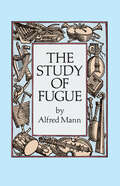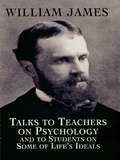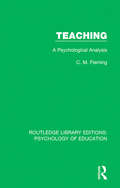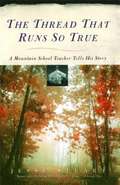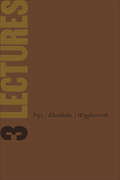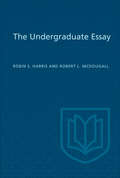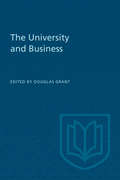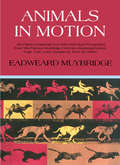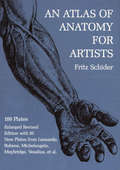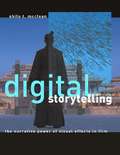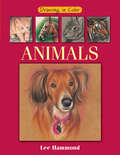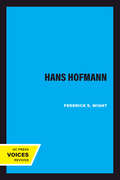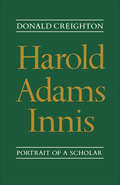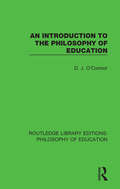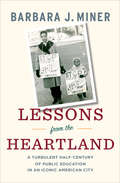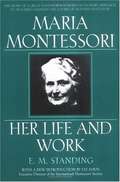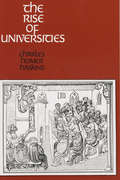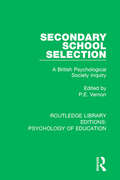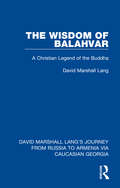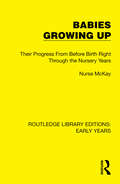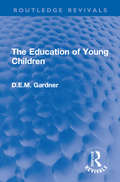- Table View
- List View
Science and the Creative Spirit
by Harcourt BrownIn the world of today, men on both sides of the science-humanities barrier feel an urgent need for mutual understanding. This symposium sponsored by the American Council of Learned Societies, stressed that it is only in a spirit of disinterested yet sincere evaluation that science and humanism can escape disastrous consequences in the future. Karl W. Deutsch (M.I.T.) deals with the general area of interplay between the sciences and the non-scientific aspects of our culture. F.E.L. Priestley (University of Toronto) discusses the impact of science on English literature. David Hawkins (University of Colorado) surveys the anthropological background of science. Harcourt Brown (Brown University) gives an account of the influence of the scientific outlook in French literary culture, and contributes an introduction explaining how the book came to be written.
Second Year Latin
by Robert J. HenleThe backbone of Henle Latin Second Year is intensive language study, including review of the first year plus new materials. Separated into four parts, Henle Latin Second Year includes readings from Caesar's Commentaries, extensive exercises, and Latin-English vocabularies. Humanistic insight and linguistic training are the goals of the Henle Latin Series from Loyola Press, an integrated four-year Latin course. Time-tested and teacher endorsed, this comprehensive program is designed to lead the student systematcially through the fundamentals of the language itself and on to an appreciation of selected classic texts.
The Story of the Nursery (Routledge Library Editions: Early Years)
by Magdalen King-HallOriginally published in 1958, this reconstruction of the lives of young children of nursery age is an excursion into the past, from the Middle Ages to the opening years of the twentieth century. It tells of the methods, often extraordinary to our ideas, by which they were brought up from babyhood to about seven years old, their clothes, diet, the fearsome remedies that were inflicted on them in illness, their toys, games, books and first steps in education. It shows how the pristine simplicity of the child’s nature, which hardly alters throughout the centuries, was moulded by the pressure of the adult society around them into some semblance of the accepted contemporary type. This story of the nursery is not only about young children, but about their parents too. There are parents in it who are stern, harsh, even cruel, and many more loving and careful ones; but one thing strikes us in these parents of former times: there is an air of unassailable confidence and certainty about them that the modern parent, versed in child psychology, would find it hard to achieve. As one seventeenth-century worthy put it, ‘For that which always happens in a concerne so universall as breeding children must needs be provided for by a traditionell method of proceeding.’
The Study of Fugue (Dover Books On Music: Analysis)
by Alfred MannClassic study comprises two parts. The first is a comprehensive historical survey of writings on the fugue from the beginning of fugal teaching (c. 1350) to the present. Part Two explores in depth four 18th-century studies which are its classical presentations: Steps to Parnassus, J. J. Fux (1725), A Treatise on Fugue, F. W. Marpurg (1753-54), Fundamental and Practical Essay on Fugal Counterpoint, Padre Martini (1775), A Manual of the Fundamental Principles of Composition, J. A. Albrechtsberger (1790). Translations of texts, introductions and critical commentary, and many musical examples. Index. Bibliography.
Talks to Teachers on Psychology: and to Students on Some of Life's Ideals
by William JamesStill-vital lectures on teaching deal with psychology and the teaching art, the stream of consciousness, the child as a behaving organism, education and behavior, and more. The three addresses to students are "The Gospel of Relaxation," "On a Certain Blindness in Human Beings," and "What Makes a Life Significant?" Preface. 2 black-and-white illustrations.
Teaching: A Psychological Analysis (Routledge Library Editions: Psychology of Education)
by C.M. FlemingOriginally published in 1968, the findings of modern psychological research had contributed much that was directly relevant to the problems of all who taught at the time. Dr Fleming here presents both recent and past conclusions in a survey that would have been useful to all who were called upon to give instruction. Since its first appearance in 1958 this book had been entirely revised and brought into line with the most modern research. Today it can be read and enjoyed in its historical context.
The Thread That Runs So True
by Jesse StuartThrough his autobiography, Stuart, wading through many obstacles and problems during his career as a teacher, finds the key to teaching--make it play, not work. When he realized this, he had very few problems with his students.
Three Lectures: University of Toronto Installation Lectures, 1958
by Northrop Frye Clyde Kluckhohn V. B. Wigglesworth Murray G. RossHundreds were turned away from these lectures given on the day of the installation of Dr. Claude Bissell as President of the University of Toronto. Professor Frye spoke on "Humanities in a New World"; Professor Kluckhohn on "The Scientific Study of Values"; and Professor V.B. Wigglesworth on "Science: Pure and Applied".
The Undergraduate Essay
by Robert McDougall Robin HarrisThe Undergraduate Essay sets before the student examples of writing from which he can learn what to do and why. Part I of this book consists of six complete essays of average undergraduate length. All are specimens rather than models; these essays are well-written, but they are not faultless. In Part II, the authors define and discuss the principles of sound essay writing by considering in turn the plan, paragraph structure, sentence structure, diction, punctuation, and under the title "The Conventions of Scholarship" the use of footnotes and the preparation of a bibliography. Throughout, the student is urged to study examples, and to think critically and constructively on the problems raised. It follows that The Undergraduate Essay makes no attempt to do the work either of the student of the instructor. It is a text which invites, indeed demands, the co-operative effort of both.
The University and Business
by Douglas GrantThe university today has to accept the responsibility of seeing that those entering business receive the training most advantageous not only to their careers but also to society itself, in which the businessman to-day plays such a significant part. But business in its turn must shoulder a greater share of the responsibility for supporting the university. The essays in this volume help to explore the relations and the mutual responsibilities of the university and business. Professor V. Bladen, Colonel W.E. Phillips, and Dean M. St.A. Woodside of the University of Toronto discuss the problem as Canadians see it; Sir Arnold Plant of London and Dean Stanley F. Teele of Harvard show the English and American attitudes. These essays were first published as a supplement to the University of Toronto Quarterly, but it was felt that as they made such a notable contribution to a problem which is bound to be debated with increasing interest for several years, they should be issued in a separate volume.
Animals in Motion
by Eadweard Muybridge"The dry plate's most spectacular early use was by Eadweard Muybridge." -- Life"A really marvelous series of plates." -- Nature (London)"These photographs have resolved many complicated questions." -- Art JournalHere is the largest, most comprehensive selection of Muybridge's famous animal photos -- more than 4,000 high-speed shots of 34 different animals and birds, in 123 different types of actions. Animals are shown walking, running, leaping, flying -- in typical actions. The horse alone is shown in more than 40 different ways: galloping with nude rider, trotting, pacing with sulky, cantering, jumping hurdles, carrying, rolling on barrels, and 36 other actions. All photos taken against ruled backgrounds; most actions taken from 3 angles at once: 90 degrees, 60 degrees, rear. Foreshortened views are included. These are true action photos, stopped in series, taken at speeds up to 1/2000th of a second. Actions are illustrated in series, with as many as 50 shots per action. Muybridge worked with the University of Pennsylvania for three years, made more than 100,000 exposures, and spent more than $50,000. His work has never been superseded as a lifetime reference for animators, illustrators, artists, and art directors.
An Atlas of Anatomy for Artists: 189 Plates: Enlarged Revised Edition with 85 New Plates from Leonardo, Rubens, Michelangelo, Muybridge, Vesalius, et al. (Dover Anatomy for Artists)
by Fritz SchiderIn this expanded edition of a classic work, Schider's complete, historical text is accompanied by a wealth of anatomical illustrations. A variety of plates showcasing master artists -- including Leonardo, Rubens, Michelangelo, Muybridge, and Vesalius -- and their classic works on anatomy are also included. Features 593 illustrations.
Digital Storytelling
by Shilo T. MccleanComputer-generated effects are often blamed for bad Hollywood movies. Yet when a critic complains that "technology swamps storytelling" (in a review of Van Helsing, calling it "an example of everything that is wrong with Hollywood computer-generated effects movies"), it says more about the weakness of the story than the strength of the technology. In Digital Storytelling, Shilo McClean shows how digital visual effects can be a tool of storytelling in film, adding narrative power as do sound, color, and "experimental" camera angles--other innovative film technologies that were once criticized for being distractions from the story. It is time, she says, to rethink the function of digital visual effects. Effects artists say--contrary to the critics--that effects always derive from story. Digital effects are a part of production, not post-production; they are becoming part of the story development process. Digital Storytelling is grounded in filmmaking, the scriptwriting process in particular. McClean considers crucial questions about digital visual effects-- whether they undermine classical storytelling structure, if they always call attention to themselves, whether their use is limited to certain genres--and looks at contemporary films (including a chapter-long analysis of Steven Spielberg's use of computer-generated effects) and contemporary film theory to find the answers. McClean argues that to consider digital visual effects as simply contributing the "wow" factor underestimates them. They are, she writes, the legitimate inheritors of film storycraft.
Drawing in Color ANIMALS: Animals (Drawing in Color)
by Lee HammondHammond's easy-to-follow techniques enable even first-time artists to render a variety of wonderful animals, from cats and dogs to horses, squirrels, tigers and more.
Hans Hofmann
by Federick S. WightThis title is part of UC Press's Voices Revived program, which commemorates University of California Press’s mission to seek out and cultivate the brightest minds and give them voice, reach, and impact. Drawing on a backlist dating to 1893, Voices Revived makes high-quality, peer-reviewed scholarship accessible once again using print-on-demand technology. This title was originally published in 1957.
Harold Adams Innis: Portrait of a Scholar
by Donald CreightonHarold Adams Innis died a quarter century ago. At the time of his death in 1952 he was Canada's pre-eminent scholar in the field of the social sciences. His reputation was based on his monumental contributions to Canadian economic history and the role of the means of communication in shaping history. As so often happens, his ideas were not greatly followed up, except by Marshall McLuhan, for some years after his death, but there is no growing recognition among Canada's scholars of the depth of his perceptions and the fruitfulness of his thought for understanding of Canada's and of world history. A close friend of Innis at the University of Toronto was Donald G. Creighton, who wrote this memoir of his life in the summer of 1953. To this paperback edition of that work, Professor Creighton has added a new introduction on its origins in the university conditions of its time. A personal tribute, the book is written in Creighton's distinctive and elegant style; it is a skilful biography which will serve well to introduce the career, character, and thought of Harold Adams Innis to a new audience. Donald Creighton himself is recognized as one of the outstanding scholars of his time. Like Innis, he has reinterpreted Canadian history in his many books and this finely crafted memoir reveals the gifts of both the biographer and his subject.
An Introduction to the Philosophy of Education (Routledge Library Editions: Philosophy of Education #14)
by D. J. O'ConnorEducation, like every other important branch of knowledge, has its underlying philosophical problems. It is these problems and the attempts to solve them which together make up the philosophy of education. This book, first published in 1957, provides a simple explanation and illustration of what philosophy can (and cannot) do for educational thinking. This title will be of interest to students of the philosophy of education.
Lessons from the Heartland: A Turbulent Half-Century of Public Education in an Iconic American City
by Barbara Miner&“Miner&’s story of Milwaukee is filled with memorable characters . . . explores with consummate skill the dynamics of race, politics, and schools in our time.&” —Mike Rose, author of The Mind at Work Weaving together the racially fraught history of public education in Milwaukee and the broader story of hypersegregation in the rust belt, Lessons from the Heartland tells of a city&’s fall from grace—and its chance for redemption in the twenty-first century. A symbol of middle American working-class values, Wisconsin—and in particular urban Milwaukee—has been at the forefront of a half century of public education experiments, from desegregation and &“school choice&” to vouchers and charter schools. This book offers a sweeping narrative portrait of an all-American city at the epicenter of public education reform, and an exploration of larger issues of race and class in our democracy. The author, a former Milwaukee Journal reporter whose daughters went through the public school system, explores the intricate ways that jobs, housing, and schools intersect, underscoring the intrinsic link between the future of public schools and the dreams and hopes of democracy in a multicultural society. &“A social history with the pulse and pace of a carefully crafted novel and a Dickensian cast of unforgettable characters. With the eye of an ethnographer, the instincts of a beat reporter, and the heart of a devoted mother and citizen activist, Miner has created a compelling portrait of a city, a time, and a people on the edge. This is essential reading.&” —Bill Ayers, author of Teaching Toward Freedom &“Eloquently captures the narratives of schoolchildren, parents, and teachers.&” —Library Journal
Maria Montessori: Her Life And Work
by E. M. StandingMaria Montessori is important background reading for parents considering Montessori education for their children, as well as for those training to become Montessori teachers. The first woman to win a degree as a Doctor of Medicine in Italy in 1896, Maria Montessori's mission to improve children's education began in the slums of Rome in 1907, and continued throughout her lifetime. Her insights into the minds of children led her to develop prepared environments and other tools and devices that have come to characterize Montessori education today. Her influence in other countries has been profound and many of her teaching methods have been adopted by educators generally. Part biography and part exposition of her ideas, this engaging book reveals through her letters and personal diaries Maria Montessori's humility and delight in the success of her educational experiments and is an ideal introduction to the principals and practices of the greatest educational pioneer of the 20th century. The new introduction to Maria Montessori: Her Life and Work by Lee Havis, executive director of the International Montessori Society, discusses the changes that have taken place in Montessori education within recent years.
The Rise of Universities
by Charles Homer Haskins Theodor E. MommsenThe origin and nature of the earliest universities are the subjects of this famous and witty set of lectures by the man whom eminent scholars have called "without exaggeration . . . the soul of the renascence of medieval studies in the United States." Great as the differences are between the earliest universities and those of today, the fact remains, says Professor Haskins, the "the university of the twentieth century is the lineal descendant of medieval Paris and Bologna." In demonstrating this fact, he brings to life the institutions, instruction, professors, and students of the Middle Ages.
Secondary School Selection: A British Psychological Society Inquiry (Routledge Library Editions: Psychology of Education)
by P. E. VernonSelection for secondary education at 11-plus still arouses widespread controversy; and the psychological techniques which are employed, such as intelligence and attainments tests, are often criticised. Originally published in 1957, under the auspices of the British Psychological Society, a group of psychologists, experienced in this field, tried to present a balanced survey of the situation at the time. They show that the real problems of secondary schooling cannot be solved by simple administrative changes; they arise from historical causes, from the class structure of English society and the educational and vocational ambitions of parents. Psychology has studied the development and differentiation of children’s abilities and interests with age, and thus throws light on the need for, and the consequences of, streaming children in different classes or schools, and the value of alternative systems such as the comprehensive school. Selection at 11-plus, it is admitted, does have harmful effects on teaching in the junior school and produces much emotional strain, though these effects are often exaggerated. It was, in fact, accurate for some ninety per cent of children; yet the implications of its inevitable inaccuracy for some pupils cannot be ignored. The functions, and the value, of intelligence and attainments tests and the essay are examined, and full consideration given to the use of teachers’ estimates of suitability and other techniques. The Report is addressed primarily to teachers, educational administrator, and psychologists – that is people with some background knowledge of the problems involved; but it should also be intelligible and helpful to the educated layman, since the more technical details are confined to Appendices.
The Wisdom of Balahvar: A Christian Legend of the Buddha (David Marshall Lang's Journey from Russia to Armenia via Caucasian Georgia #3)
by David Marshall LangOriginally published in 1957 and forming a companion volume to The Balavariani, this volume provides valuable research into the biography of Gautama Buddha and its influence on medieval Christian thought. This work, the romance of Barlaam and Josaphat, was included by Caxton in The Golden Legend and inspired the episode of the Caskets in Shakespeare’s The Merchant of Venice; its heroes were venerated as Saints. Over a century ago, however, the legend was finally identified as an adaptation of episodes from the life and ministry of the Buddha. The first part of the book is devoted to tracing the development and migration of the Barlaam and Josaphat legend from its original Buddhist environment to the West. The second part is a translation of the Georgian text – the first published in any Western European language. The volume therefore gives one of the oldest Near Eastern versions of the story.
Babies Growing Up: Their Progress From Before Birth Right Through the Nursery Years (Routledge Library Editions: Early Years)
by Nurse McKayOriginally published in 1956, Babies Growing Up aims to compress in to a brief yet readable form, the essentials of successful parentcraft at the time, bearing in mind the four elements of developing a new life – physical, mental, emotional and spiritual. It seeks to sum up the essence of the mothercraft advice given over the years through the pages of Woman’s Pictorial and Mother and Home, where some material had appeared previously. It is a comprehensive guide through a baby’s life from birth through the early years and today can be enjoyed as a historical look at parenting and child development in the 1950s.
The Education of Young Children (Routledge Revivals)
by D.E.M. GardnerFirst published in 1956, The Education of Young Children is focused on presenting the psychological needs of children within education, following several talks given by the author at conferences for teachers of young children. The book highlights the importance of meeting all aspects of a child’s needs. It demonstrates that physical, emotional, social, and intellectual needs are all intrinsically connected and fundamental to education and development. It also puts forward the significance of Nursery Schools and the training given to Nursery School teachers, as well as the influence of Nursery Schools on Infant Schools. The Education of Young Children will appeal to those with an interest in the history and psychology of education.
The Intellectual Life of Colonial New England
by Samuel Eliot MorisonDescribes the thought of New England's scholars during the period.
